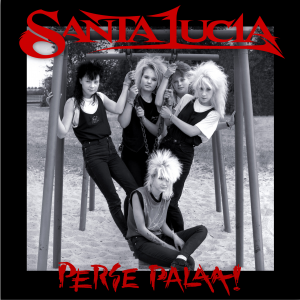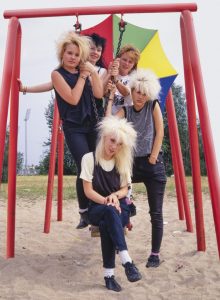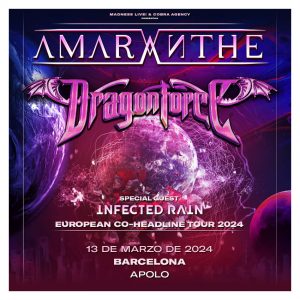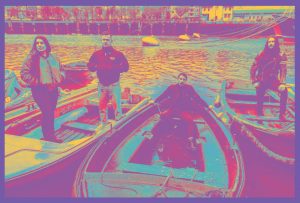SANTA LUCIA (EN)
– Hello and, first of all, thanks for taking your time to answer to our questions. How does it feel to release material again after such a long time?
Thank you Tania, we’re happy and honoured to be contacted by the Queens of Steel. As a matter of fact, this is what we felt when we were contacted by Svart Records. We kind of had already made the decision that this was it. Twice! In 1992 when we decided to officially call it a day and 2013 after few reunion gigs. Being contacted by the Svart Records and them convincing us it is worthwhile to release the triple, we just thought “okay… you just go ahead…” But all this interest towards us came totally out of the blue – yet, it feels absolutely amazing!
– To begin with, how did SANTA LUCIA born? You were 12 years old when you formed the band, so I guess this was your first musical experience.
We (Mape, Sipe, Kultsi and Häte) got to know each other in primary school at the age of seven and Aide joined the group a couple of years later. We did have quite strong background from the music academy and classical music, but we also listened to rock, went to see bands and followed the few pop and rock features there were on the television at that time. In thinking of what really gave the kick-off for our own band was the rise of Finnish-rock scene in the early 80s. Some of the bands had a strong impact on us musically and what comes to the rock-chick habitus.
– And what does the band name represent? I suppose it’s a reference to Lucian Paiva.
In a way, yes, because the Saint Lucy’s Day (13th of December) used to be the longest night of the year, so it’s all about the long winter and darkness, but moreover it is about the martyr Saint Lucy, lady in a white dress and with candles, whom we celebrate in Scandinavia, and who brings the light into the world darkness. At first the name was a joke and a statement to us: Saint Lucy representing the beautiful and conventional female figure, the total opposite to us, as we thought. Retrospectively there is much more in the story of Saint Lucy than we initially considered: it is an intriguing story as such but also from the metal-narrative point of view.
– A few years after having been formed you released some singles, until your debut album came out in 1990. How were those first steps like? What kind of activity did you have during those years prior to releasing your first album?
We played and played and played, as evidenced in Mape’s diary from those years. Honestly, we exercised seriously and a lot! We rehearsed at our drummers grandma’s ex-place, our parents got extremely supportively involved by buying us better instruments, celebration year Marshall amps, for instance, and in many ways it was serious business to us. At the same time, we had super-cool and boozy parties at our rehearsal place. And at the same time, we were just as uncertain and problematic teenagers going to high-school as the rest of our age-group.
– Before the debut you signed to Poko. How did it feel for a group of teenage girls without an album yet, to get signed by a record label?
As in many issues, we did not really find that so very peculiar, but were more like, “so…? isn’t this what bands do…? “Even though we were very serious about our music and the band, we did not ever really plan anything like: “this is what we do in a one year of time”; and “this is where we are in three years time”. We just played! And we played well. And we knew that. Maybe that is the reason why the issue of being signed to a label seemed somewhat “normal”. But the occasion itself, to get the contract, was unique and very unnormal to us. We were sixteen and performed a supporting show in Tampere. Our booking agent Jouko Karppanen had invited Epe Helenius, the head of Poko Records, to see the ”interesting band from up north” and after the show we were expecting a label mogul come meet us with a fat cigar in his mouth. Then Epe arrived with a sports cap on and asked right away “when we’d like to release a single and who we want to produce it?”
– Then «Arktista hysteriaa» saw the light of day in 1990. What are your memories from the whole process? Now it is considered a cult album, I guess you didn’t expect this back then.
As was typical of the era, studio schedules were tight and time was of the essence. We recorded the album during an Easter holiday from high school at the legendary Tico Tico Studio in our home-town Kemi – butthole of the Bothian bay, as it was renamed. The first few days we just played cards, had coffee (a lot) and smoked fags (a lot). We decided to self-produce the album Arktista hysteriaa (Arctic hysteria) and interestingly the label allowed this – incredible in retrospect. On the other hand it shows how the label allowed us to fully be ourselves. There were absolutely no limits.
– What prompted that you split up in 1992? The music industry changed a lot when Grunge irrupted and it was tough for most Metal bands. Did this affect you in any way?
Life! We formed the band at the age of 12 and played until we were in our twenties. We were together through our entire youth but then we split around the country after our studies. There was no great drama involved in the decision. On the contrary, we were thankful for the journey we’ve had together. At the time we had to consider how much time and effort each of us are willing to invest in the band in the situation where everyone lives far apart from the others, we did not have serious and analytical conversation about what each of us expects from the band, but at that point our future plans just didn’t involve the band (passionately enough) anymore.
– You played Heavy Metal with Speed Metal hints, but also throwing elements from Rock or even Post Punk. What bands were you into back in those days?
In alphabetical order… Cyndi Lauper, D-A-D, The Doors, Duran Duran, Faith No More, Guns N’ R0ses, Hanoi Rocks, Hassisen Kone, Holy Moses, Iron Maiden, Madonna, Metallica, Peer Gunt, Pink Floyd, Police, Queensrÿche, Rainbow, Sade, U2, Voivod……
– You were basically the first only-women Metal band coming out from Finland, so near you you did’t have many women to look at for inspirations. Did you have any (female) role models or women artists that motivated you to pick up your instruments?
Not really. In the late 80’s/early 90’s there was quite a strong feminist pop-rock movement in Finland and we participated some of the Rockluuta (Rock Broom) activities. However, at the time, we did not quite catch the point of the female hazzle. We just played. But we did have amazing women around us: our mothers.
– How easy was to get gigs and not being discredited for a band formed only by girls back then? Do you think you had to work harder than if you had been men?
For us, we were a band and not a female-band by definition. We were a group of friends who just happened to establish a band. But as said earlier, we did work hard and believed in what we were doing, and we believed that was the main reason why we got the gigs and the contract etc. Janne Joutsenniemi, bassist-singer of the most popular ever Finnish thrash metal band Stone has mentioned that to him it was a “cherry-on-the-top” kind of an issue that we were all females but otherwise what mattered was that we were bloody tough group – and our talk was as shitty as theirs not to mention how bad-ass beer-drinkers we were. Our booking agent Karppanen recalled: ”I took them in my roster because I liked them and their attitude. They had come up with a unique style and concept. They were very, very unique, didn’t copy anybody. On stage they had plenty of energy.”
– Rock and Metal have always been male-dominated communities and in art in general women have always been made invisible, so Metal is not an exception. Do you think the role women play on the Metal world (and the way the crowd/society perceives them) has changed since you were active during the 80’s/90’s?
Generally speaking there are now more women in the business, there are single bands and individual pioneers internationally and in Finland, but the prominent invasion of female bands still awaits. Even today it seems to be more common to enroll girls into music academy than to encourage them to grab (rock-)instrument and set up a band. Gender and appearance also seems to be the issue to talk about female musicians in the media rather than their music. Apparently, there’s still a lot to be done at home, by the music-teachers and media, if we wish to see more balanced and equal rock and metal scene.
– Now the «Perse Palaa» compilation has just came out. How did everything arise? And working with Svart? They are doing a lot for Finnish Rock.
The work by Svart for Finnish rock is unreal and we are grateful to be part of this history. We also appreciate how much they have respected our views how we’d like to work and build our story. This has been a true joint initiative.
– It’s coming out in 2019, which means people are still interested in SANTA LUCIA. Did you know there was this interest? Have you notice you have probably reached new people (and younger generations) with tools such as the Internet?

We did not have the slightest idea that there exists such a thing as Lucia-fan, let alone that there would be quite a number of them. We were so in the margin at our time and thought we remained there. When we played the reunion gigs some years ago, we were absolutely mind-blown. And now posting out T-shirts overseas… we couldn’t be more confused. And delighted!
– Anyway you have always remained in the underground, do you think if your lyrics had been in English you would have probably got to a bigger audience? Did you ever consider having some songs in English?
Well, in brief, we were happily out-of-the-mainstream because anything normal sucked 🙂 Kultsi’s lyrics sounded fittingly complex and morbid, which was a driving force behind everything we did. Nowadays there is an ample metal-scene in Finland with Finnish lyrics but at the time when we chose to sing in Finnish it was considered a very weird choice. Kultsi’s lyrics also differed from the clichés of heavy metal. Santa Lucia’s lyrics were poetic and bizarre, and they went deeper inside the human mind. ”Kiristävä silmä, hirttäytynyt päähäni, ulos pullistuu, pudottautuuko käteeni? Kun katsot lävitseni, näet ahdasmielisen eläimen, kun kuljet lävitseni, tunnet laajentuneen kasvaimen.” (”The strained eye, hanged itself in my head, bulging out, does it fall into my hand? When you look through me, you see a narrow-minded animal, when you walk through me, you feel a tumour spreading.” Santa Lucia: Kiristävä silmä [Strained eye]). Unsurprisingly the band’s lyrical content went over most people’s heads.
– This compilation features all your material, including the «Neljä Tunnelia Tuonelaan» EP, which was never released on vinyl. If I’m not mistaken it only came out in CD, what was the reason behind this? As considering the time when it was released it’s surprising it wasn’t out on tape as well, or even vinyl.
This is an interesting question. I cannot recall if the format was ever even discussed… That was probably the time when vinyls gave away to CDs and maybe also for being only EP…
– It also contains unreleased material. What are these songs and when are they from? Are they leftovers or you had in mind to release something else at some point?
The unreleased material are drawn from several demos from 1987 – 1991. Some of them were left out from the album and EP, or they were the b-sides of our singles, because they differed so much from the other material and style; some of them just remained (too) unfinished. All in all, we have selected songs from our demos that we particularly cherish.
– That’s all, thank you once more for answering our questions. If you want to add some final words; feel free to do it.
At this point – and with this life-experience – we consider ourselves as “lucky bastards” for all the opportunities that there were for us. At the same time, we are extremely proud of our accomplishments.
Tania Giménez
tania@queensofsteel.com







